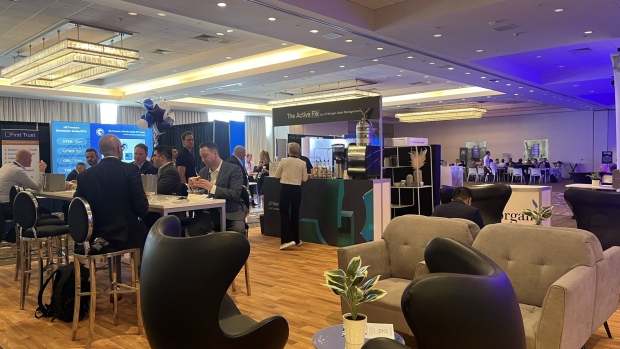Feb 9, 2023
Crypto Gives Way to Vanguard as ETFs Get ‘Back to Basics’
, Bloomberg News

(Bloomberg) -- For the nearly 2,000 attendees of the ETF Exchange conference, a lot has changed in a year.
Industry professionals and financial advisors who gathered once again in Miami, Florida, this week noticed a slight vibe shift — away from risky areas of the market. While speculative assets like Cathie Wood’s funds rallied at the start of this year, the impact of 2022’s rout was evident.
Panels about cryptocurrency, conversations around growth-oriented strategies like environmental, social, and governance (ESG) and single-stock ETFs, as well as Wood’s ARK Investment Management were all missing from the conference. In their place were industry heavyweights like Vanguard Group — the world’s second-largest ETF manager. There was even a panel celebrating the industry’s oldest product: the SPDR S&P 500 ETF Trust (ticker SPY).
This year was more “back to the basics” said Athanasios Psarofagis, ETF analyst with Bloomberg Intelligence. “2022 was all crypto. This year the booths for the thematic products were definitely smaller.”
Psarofagis noted the absence of Wood, who “was on a bunch of panels,” in 2022. ARK, which did not have a booth or sponsor the four-day event after being a top sponsor last year, declined to comment.
Other notable no-shows were speakers and booths from firms like Grayscale Investments and Valkyrie Funds, which had huge presences last year, when many crypto enthusiasts extended their stays in Miami for a week and there were debates over when the US Securities and Exchange Commission would approve a spot Bitcoin ETF in the US. This year one of the only event booths with a crypto focus was in the back corner of the conference hall.
A Grayscale spokesperson said the firm’s ETF team was in Miami, but other members of the team are spending time in Washington DC ahead of oral arguments in March for Grayscale’s lawsuit against the SEC to convert GBTC to an ETF. Valkyrie declined to comment.
Even conference merch had a little less flair. “I feel like they were handing out really cool stuff last year. This year, it’s just back to mugs,” said Psarofagis.
ETF mainstays State Street, Invesco Ltd. and BlackRock’s iShares dominated the front hall of the event. JPMorgan Chase & Co. stood out with its cafe-style booths. Conversations focused on dividend-ETFs, so-called “buffer-ETFs” that protect investors from big losses during market downturns, and low-volatility funds.
“Even the firms that are here back-to-back years, what they’re showcasing is more defensive and more cognizant of the environment we’re in today where there’s likely to be slower growth, where there’s a need for stability, even fixed income,” said Todd Rosenbluth, head of research at VettaFi, which produces the ETF Exchange conference.
Actively managed ETFs were also in focus. While the first ETFs introduced passive, index-tracking strategies, active funds are becoming more popular. JPMorgan’s asset management arm estimates the strategy will grow to make up to 20% of total ETF assets in five years.
Despite the conference’s lack of bull-market euphoria, the industry is coming off of its second best year for inflows and launches. While growth-oriented strategies were less in favor, conference attendees were hopeful.
“I still felt that there was a healthy, realistic optimism,” said Amrita Nandakumar, president at ETF sub adviser Vident Investment Advisory. “There’s an optimism that hey, maybe 23 won’t be as bad as 22. And regardless, as participants in this industry, we can continue to innovate and to launch interesting new products that investors are looking for and continue to move the industry forward.”
©2023 Bloomberg L.P.





